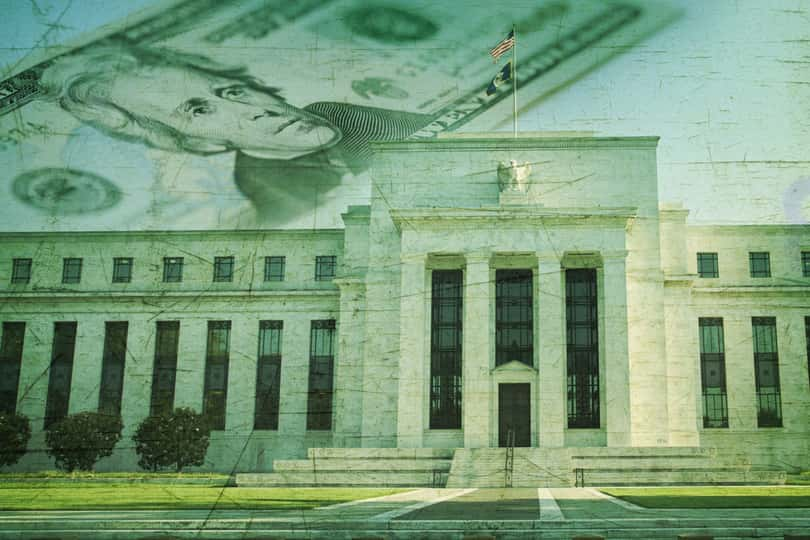Banking stocks suffered a free fall in March as the COVID-19 coronavirus hit the economy fast and hard. This tumble was due primarily to investors’ concerns over potential loan losses that banks might face amid a low-rate environment, the Fed’s asset purchases, skyrocketing unemployment, and sliding gross domestic product. Consequently, the Fed limited the dividends banks could pay and banned share buybacks as precautionary measures to ensure that the sector had enough capital to function during the pandemic.
Banking stocks rallied sharply Monday after the Federal Reserve Board released the Comprehensive Capital Analysis and Review (CCAR) Round 2 stress test results on Friday. The Fed announced that it will allow the nation’s big banks to resume share buybacks in the first quarter of 2021 subject to certain rules.
The report also showed that large banks had strong capital levels under two separate hypothetical recessions over nine future quarters. The new rules stipulate the sum of a bank’s dividend payments and buybacks in the first quarter cannot exceed the average quarterly earnings from its four most recent fiscal quarters. In addition, the Fed said it will not reset firms’ capital requirements at this time. According to Bloomberg, the six biggest U.S. banks (including the three banks we discuss below) could buy back as much as $11 billion in shares in the first quarter of next year.
The stress test results generally highlighted the resilience of the banking sector despite the challenges posed by the pandemic. JPMorgan Chase & Co. (JPM), Citigroup, Inc. (C) and Wells Fargo & Company (WFC) should gain significantly going into 2021.
JP Morgan Chase & Co. (JPM)
JPM is a leading global financial services firm with assets of $3.2 trillion and operations in more than 60 countries worldwide. The firm is a leader in investment banking, commercial banking, and asset management. It operates in four segments – Consumer & Community Banking (CCB), Corporate & Investment Banking (CIB), Commercial Banking (CB), and Asset & Wealth Management (AWM).
JPM excelled in the CCAR Round 2 stress test. The firm’s Basel III Standardized approach minimum Common Equity Tier 1 (CET1) capital ratio remained at 11.3%, inclusive of the Stress Capital Buffer (SCB) requirement of 3.3%. Consequently, the company’s board has approved a new common equity share repurchase program of $30 billion.
In the third quarter ended September 30, 2020, JPM posted revenue of $29.9 billion, which was relatively flat compared to the year-ago quarter. This was primarily driven by a 21% year-over-year rise in the CIB sector. The company set aside $611 million as a provision for credit losses to maintain its credit reserves at $34 billion. While its average loans were up 1%, its average deposits surged 30% year-over-year. EPS for the quarter came in $2.92, rising 112% sequentially.
JPM is benefiting from its strong capital, massive reserves, and solid liquidity position. Its client- driven business model and footprint expansion have allowed it to capture significant market share in several operations. Hence, analysts expect JPM’s EPS to grow 198.7% next quarter and 20.8% next year.
How does JPM stack up for the POWR Ratings?
A for Trade Grade
B for Buy & Hold Grade
B for Peer Grade
B for Industry Rank
B for Overall POWR Rating.
It is ranked #3 in the 10-stock Money Center Banks industry.
Citigroup, Inc. (C)
C is a diversified financial service holding company that provides various financial products and services, banking, credit card lending, and investment services in North America and internationally. The firm operates primarily through three segments – Global Consumer Banking (GCB), Institutional Clients Group (ICG), and Corporate/Other.
C issued a statement on Friday highlighting its intention to resume a share buyback plan and to pay a $0.51 dividend per share from 1Q through 3Q of fiscal 2021.
The stress test report enabled the bank to take certain capital actions during the first quarter of fiscal 2021, subject to certain restrictions, while extending the period for notification regarding the recalculation of C’s stress capital buffer requirement through March 31, 2021.
C reported total revenue of $17.3 billion in the third quarter, representing a 7% decline year-over-year. This primarily reflects lower revenues in GCB and Corporate segments. While average loans decreased 4% during the quarter, average deposits increased 16% year-over-year, to $1.3 trillion, driven by a 17% increase in GCB and a 16% increase in ICG. Provision for credit losses was $26.4 billion, representing 4% of total loans. EPS for the quarter came in $1.40, rising 180% sequentially.
C has managed to stabilize its credit costs this year. Its management believes “the backbone of our global network, Treasury and Trade Solutions, experienced strong client engagement in the face of low interest rates.” The firm has witnessed significant growth in Fixed Income Markets, Investment Banking, Equity Markets and in its Private Bank this year. As a result, analysts expect C’s EPS to grow 44.5% next year.
C’s momentum is reflected in its POWR Ratings; it has a “Buy” rating with a “B” in Trade Grade and Industry Rank. Within the Money Center Banks industry, it is ranked #5 of 10 stocks.
Wells Fargo & Company (WFC)
WFC is a diversified, community-based financial services company with $1.92 trillion in assets, operating through 7,200 locations in 31 countries worldwide. The firm provides banking, investment, mortgage, and consumer and commercial finance products and services to individuals, businesses, and institutions. WFC functions through three segments – Community Banking, Wholesale Banking, and Wealth and Investment Management.
In response to the Fed’s report, WFC announced that it will resume its share buybacks and will continue dividend payments in the first quarter of fiscal 2021. The Fed also extended the notification period regarding the recalculation of WFC’s stress capital buffer requirement through March 31st, 2021. As part of its response, WFC said, “While we expect to have modest capital distribution capacity in the first quarter, we continue to have significant excess capital above regulatory requirements.”
WFC reported impressive third-quarter results, with $18.9 billion in revenues, rising 6% sequentially. Though this implied a 19.6% year-over-year decline, the firm generated strong mortgage banking fees, higher equity markets, and declining sequential charge-offs that positively impacted its top-line. Its average loans were $931.7 billion, down $39.6 billion from the second quarter. Total average deposits came in at $1.4 trillion, up $12.4 billion from the prior quarter. And provision for credit losses remained relatively flat compared to the prior quarter, cumulating at $20.5 billion so far this year. EPS for the quarter came in at $0.42, compared to the quarter-ago loss of $0.66 per share.
WFC is prioritizing the implementation of its risk, control, and regulatory requirements to improve its operational and financial performance. Moreover, the firm remains strong with its capital and liquidity levels well above regulatory minimums. In line with its progress, analysts expect the company’s EPS to grow 480% next year.
Under POWR Ratings, WFC has been accorded a “B” rating for Industry Rank. Out of 10 stocks in the Money Center Banks industry, the company is ranked #7.
Want More Great Investing Ideas?
9 “MUST OWN” Growth Stocks for 2021
Where is the Santa Claus Stock Rally?
5 WINNING Stocks Chart Patterns
JPM shares were trading at $122.63 per share on Tuesday afternoon, down $0.92 (-0.74%). Year-to-date, JPM has declined -8.84%, versus a 15.95% rise in the benchmark S&P 500 index during the same period.
About the Author: Sidharath Gupta

Sidharath’s passion for the markets and his love of words guided him to becoming a financial journalist. He began his career as an Equity Analyst, researching stocks and preparing in-depth research reports. Sidharath is currently pursuing the CFA program to deepen his knowledge of financial anlaysis and investment strategies. More...
More Resources for the Stocks in this Article
| Ticker | POWR Rating | Industry Rank | Rank in Industry |
| JPM | Get Rating | Get Rating | Get Rating |
| C | Get Rating | Get Rating | Get Rating |
| WFC | Get Rating | Get Rating | Get Rating |






